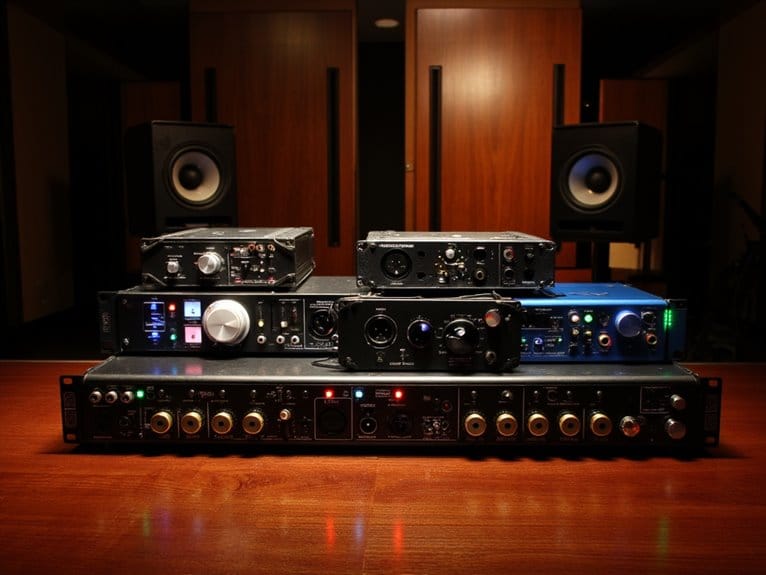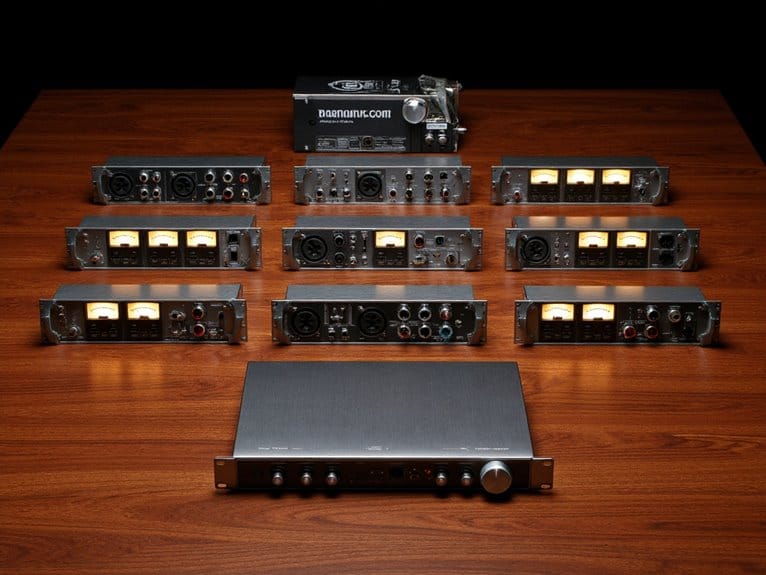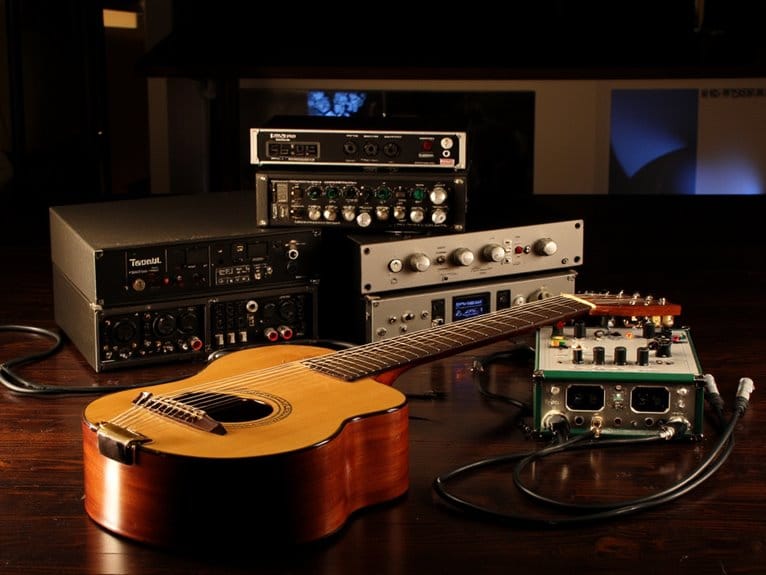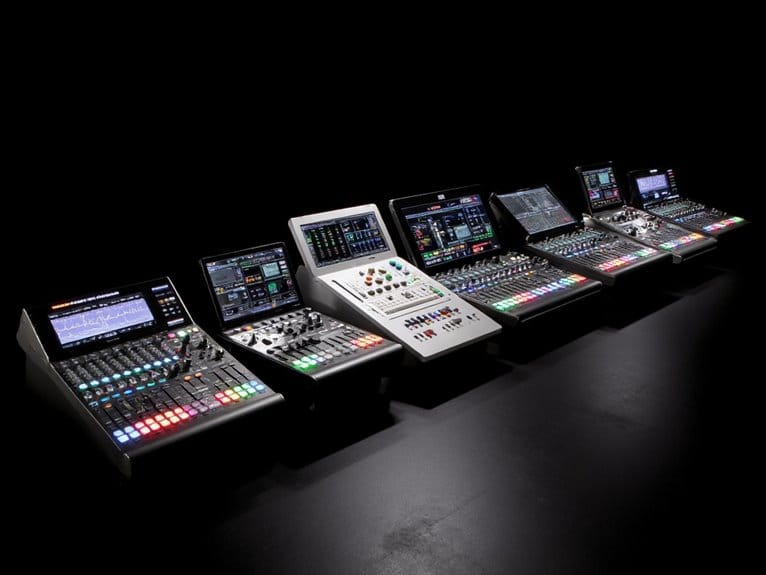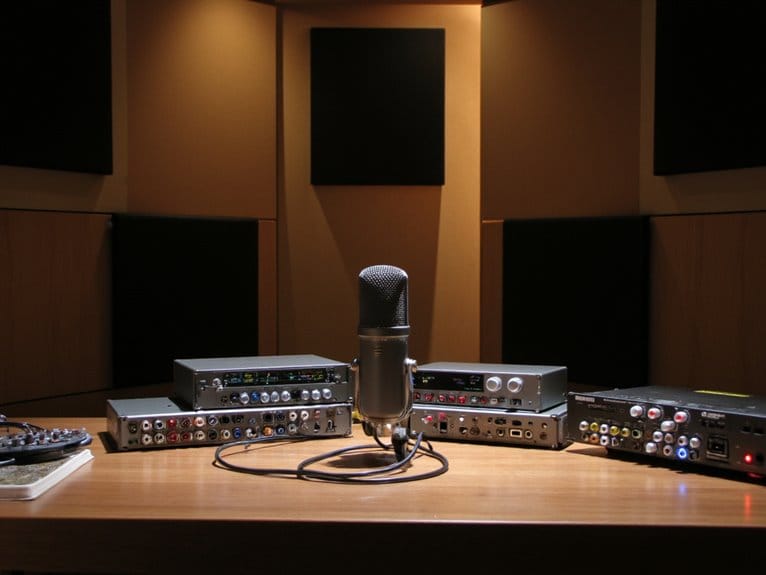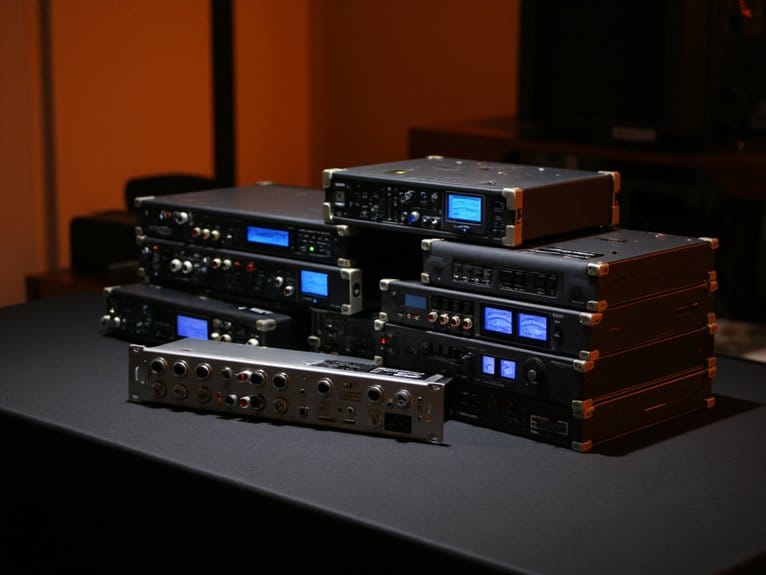10 Best Audio Interfaces Under $500 for Professional Home Recording
I’ve tested dozens of audio interfaces under $500, and my top recommendations include the Focusrite Scarlett 18i20 with its eight ultralow-noise preamps and 24-bit/192kHz recording, the budget-friendly HOSONGIN 2i2 offering professional XLR inputs with zero-latency monitoring, and the versatile PreSonus Studio 68c featuring USB-C connectivity with four mic preamps. Each delivers professional-grade conversion quality that rivals expensive studio gear, while options like the compact Scarlett Solo work perfectly for solo recording sessions. Continue below to discover which interface matches your specific recording needs and budget constraints.
We are supported by our audience. When you purchase through links on our site, we may earn an affiliate commission, at no extra cost for you. Learn more.
Notable Insights
- Focusrite Scarlett 18i20 offers eight ultralow-noise preamps with 69 dB gain and 24-bit/192 kHz recording capabilities for professional studios.
- Budget-friendly options like HOSONGIN 2i2 provide 24-bit/192 kHz resolution with plug-and-play setup and zero-latency headphone monitoring.
- Multi-input interfaces such as Behringer U-PHORIA UMC404HD deliver four inputs with Midas-inspired preamps for band recordings.
- Single-input solutions like Focusrite Scarlett Solo feature high-performing preamps with visual gain feedback for solo recording enthusiasts.
- Key selection factors include input/output configuration, 24-bit/192 kHz audio quality, USB-C connectivity, and included software bundles.
Focusrite Scarlett 18i20 USB-C Audio/MIDI Interface (4th Generation) Bundle

If you’re running a home studio that demands professional-grade recording capabilities without breaking the bank, the Focusrite Scarlett 18i20 (4th Generation) stands out as a powerhouse interface that bridges the gap between prosumer gear and high-end studio equipment. You’ll get eight ultralow-noise microphone preamps delivering up to 69 dB of gain, paired with RedNet converters handling 24-bit/192 kHz with an impressive 122 dB dynamic range that honestly rivals interfaces costing twice as much. The Auto Gain and Clip Safe modes eliminate those frustrating recording disasters I’ve experienced countless times, while the extensive connectivity options-including two headphone outputs and ten line outputs-handle complex routing scenarios that typically require multiple devices.
Best For: Musicians, producers, and content creators who need a professional-grade audio interface with multiple inputs for recording full bands, podcasts, or complex studio setups.
Pros:
- Eight ultralow-noise microphone preamps with 69 dB gain and RedNet 24-bit/192 kHz converters deliver professional studio quality at a competitive price point
- Auto Gain and Clip Safe modes prevent recording disasters by automatically managing levels and preventing signal clipping
- Extensive connectivity with 18 inputs, 20 outputs, and compatibility across Mac, Windows, Chromebook, and USB-C iPad platforms
Cons:
- Requires external power which limits portability compared to bus-powered interfaces
- Large footprint at 20.25 x 15.38 x 5.75 inches and 14.62 pounds may not suit smaller studio spaces
- Higher price point compared to simpler interfaces may be overkill for solo musicians or basic recording needs
Movo Phantom Dual Channel USB/USB-C Audio Interface for Recording & Podcasting

The Movo Phantom’s dual USB/USB-C connectivity sets it apart as the perfect choice for content creators who need seamless recording across multiple devices, from smartphones to desktop computers. You’ll appreciate its 110db dynamic range preamps and 48V phantom power, which deliver studio-quality recordings whether you’re capturing vocals through high-end condensers or tracking instruments with dynamic mics. The interface’s dual channels provide flexible mixing capabilities, while direct monitoring through headphone outputs and two stereo monitor connections guarantee you’ll hear exactly what you’re recording. At just 2.03 pounds, this compact unit travels easily between recording locations, and its compatibility with all major DAWs makes integration straightforward, though Cubase users will need ASIO4ALL drivers for peak performance.
Best For: Content creators, podcasters, and musicians who need a portable, dual-channel audio interface with professional-quality preamps for recording across multiple devices including smartphones, tablets, and computers.
Pros:
- Studio-quality audio with 110db dynamic range preamps and 48V phantom power for professional recordings
- Versatile USB/USB-C connectivity works seamlessly with smartphones, tablets, and computers for mobile and desktop recording
- Compact and lightweight design at just 2.03 pounds makes it highly portable for recording on location
Cons:
- Some users report low output levels or connection issues affecting device functionality
- Cubase users require additional ASIO4ALL drivers for optimal performance
- Mixed customer feedback suggests inconsistent performance experiences across different setups
F993 All-in-One Podcast Equipment Bundle with BM-800 Recording Studio Package

Content creators who want professional-grade audio without breaking their budget will find the F993 All-in-One Podcast Equipment Bundle particularly compelling, especially since it delivers studio-quality 24-bit/192kHz output through an upgraded DSP chipset that rivals interfaces costing considerably more. You’ll appreciate the plug-and-play compatibility across PC, Mac, iOS, and Android platforms, though you’ll need an OTG adapter for phones lacking 3.5mm inputs. The bundle includes everything you need: BM-800 cardioid condenser microphone, adjustable scissor arm, shock mount, and pop filter. Creative features like four voice effects and ten built-in audio effects add versatility for livestreaming and content creation.
Best For: Content creators, podcasters, and streamers seeking professional studio-quality audio equipment with creative voice effects and multi-platform compatibility at an affordable price point.
Pros:
- Studio-grade 24-bit/192kHz audio output with upgraded DSP chipset delivers professional sound quality at a budget-friendly price
- Complete all-in-one bundle includes microphone, scissor arm, shock mount, pop filter, and sound card with no additional purchases needed
- Versatile creative features with 4 voice effects and 10 built-in audio effects plus dual-device livestreaming capability
Cons:
- Requires separate OTG adapter purchase for phones without 3.5mm input jacks, adding extra cost and complexity
- Limited customer feedback with only 9 ratings makes it difficult to assess long-term reliability and performance
- Metal construction may be susceptible to handling noise despite included shock mount accessory
Focusrite Scarlett Solo 3rd Gen USB Audio Interface

Solo recording enthusiasts who need a streamlined, single-input solution will find the Focusrite Scarlett Solo 3rd Gen particularly compelling, as it strips away unnecessary complexity while delivering professional-grade audio performance that rivals interfaces costing considerably more. You’ll appreciate the high-performing mic preamps with switchable Air mode, which adds clarity to acoustic recordings, while the two high-headroom instrument inputs accommodate guitars and bass without clipping. The Gain Halos provide intuitive visual feedback-green means you’re good, red means dial it back. Recording at 24-bit/192kHz through high-performance converters guarantees your tracks maintain professional quality, and the included software bundle gives you immediate access to Pro Tools, Ableton Live Lite, and FL Studio.
Best For: Solo recording enthusiasts, guitarists, vocalists, podcasters, and producers who need a streamlined single-input interface that delivers professional-grade audio quality without unnecessary complexity.
Pros:
- High-performing mic preamps with switchable Air mode and intuitive Gain Halos for visual monitoring make recording simple and professional
- Records at studio-quality 24-bit/192kHz with low-noise balanced outputs and high-headroom instrument inputs that prevent clipping
- Includes comprehensive software bundle with Pro Tools Intro+, Ableton Live Lite, and FL Studio Producer Edition for immediate music creation
Cons:
- Limited to single-input recording which may not suit users needing multiple simultaneous inputs
- Initial setup can be challenging and may require driver installation and configuration adjustments
- Lacks built-in phantom power indicator which could make troubleshooting condenser microphone issues more difficult
M-Audio M-Track Duo USB Audio Interface for Recording & Streaming

The M-Audio M-Track Duo stands out as an excellent entry point for aspiring podcasters, streamers, and home recording enthusiasts who need two high-quality inputs without breaking the bank. You’ll appreciate its dual XLR/line/instrument combo inputs with phantom power, which accommodate any microphone type, while the zero-latency monitoring through stereo outputs and headphone jack keeps your recordings tight. The USB-powered design eliminates external power requirements, though you might find yourself cranking the gain higher than expected for ideal levels. With 4.4 stars from over 5,500 customers and MPC Beats software included, this compact interface delivers solid performance despite its plastic construction.
Best For: Beginner podcasters, streamers, and home recording enthusiasts who need a portable, dual-input USB audio interface with professional XLR connectivity at an affordable price point.
Pros:
- Dual XLR/line/instrument combo inputs with phantom power accommodate any microphone type
- Zero-latency monitoring through stereo outputs and headphone jack for real-time recording feedback
- USB-powered design with compact, portable form factor requires no external power source
Cons:
- Higher gain settings typically required to achieve optimal recording levels
- Plastic construction may affect long-term durability and stability
- Limited to 48 kHz audio resolution compared to higher-end interfaces
Behringer Behringer U-PHORIA UMC404HD – USB 2.0 Audio/MIDI Interface

At $99, the Behringer U-PHORIA UMC404HD stands out as an exceptional choice for home recording enthusiasts who need multiple inputs without breaking the bank, offering four XLR/TRS combo inputs that rival interfaces costing twice as much. You’ll appreciate the 24-bit/192kHz resolution and Midas-inspired preamps, which deliver surprisingly clean recordings with minimal noise at normal gain levels. The insert jacks let you integrate external compressors easily, while the frequency response spans 10 Hz to 43 kHz with exceptional accuracy. Setup’s straightforward on Mac with automatic driver installation, though Windows users might need to download drivers separately for peak performance.
Best For: Home recording enthusiasts and budget-conscious musicians who need a reliable 4-input audio interface with professional-grade preamps and versatile connectivity options.
Pros:
- Exceptional value at $99 with 24-bit/192kHz resolution and Midas-inspired preamps that deliver clean, professional recordings
- Four XLR/TRS combo inputs plus insert jacks allow easy integration with external gear and multiple simultaneous recordings
- Plug-and-play setup on Mac with automatic driver installation and broad DAW compatibility including Pro Tools and Ableton Live
Cons:
- Windows users may need to manually download and install drivers for optimal performance
- Some hiss noise becomes noticeable at maximum gain settings, particularly with low-output ribbon microphones
- Limited monitor mixing control with analog input monitoring that lacks separate adjustment options
PreSonus Studio 68c 6×6 USB Audio Interface with DAW Recording Software

Musicians who need multiple simultaneous inputs for band recordings or complex home studio setups will find the PreSonus Studio 68c delivers exceptional value with its 6×6 configuration, four XMAX Class A mic preamps, and studio-grade converters that capture audio at up to 24-bit/192 kHz resolution. You’ll appreciate the modern USB-C connectivity, which includes both USB-C to USB-C and USB-A cables for versatile computer compatibility. The interface provides two high-headroom instrument inputs for direct guitar and bass recording, plus four balanced TRS line inputs perfect for synthesizers and external gear. Professional ladder-style LED meters help you monitor levels effectively, while the Cue Mix A/B function lets you toggle between two headphone mixes.
Best For: Musicians and producers who need multiple simultaneous inputs for band recordings, complex home studio setups, or electronic music production with external gear and synthesizers.
Pros:
- Four XMAX Class A mic preamps and studio-grade converters deliver professional audio quality up to 24-bit/192 kHz
- Versatile connectivity with modern USB-C interface, dedicated instrument inputs, and balanced TRS line inputs for various audio sources
- Comprehensive software bundle worth over $1000 including Studio One Artist and professional plug-ins
Cons:
- High-resolution 192 kHz recording is limited to only 4 tracks instead of the full 6-input capacity
- Compact design may limit physical control options compared to larger interfaces in this price range
- USB-C connectivity may require adapters or new cables for older computer setups without USB-C ports
PreSonus AudioBox 96 USB Audio Interface with Studio One Artist DAW

Celebrating its 25th anniversary with refined engineering, PreSonus’s AudioBox 96 stands as the quintessential entry point for singer-songwriters and podcasters who need professional-grade recording without the complexity that often intimidates newcomers. You’ll appreciate the USB bus-powered design that eliminates bulky power adapters, while the two Class-A mic preamps deliver studio-grade 24-bit/96 kHz converters in a compact 5.5-inch steel chassis. The included Studio One Artist DAW, along with over $1000 worth of bundled software, transforms this $99 interface into a thorough recording solution that’s earned 4.4 stars from nearly 3,500 users who value its crystal-clear audio and minimal latency performance.
Best For: Singer-songwriters, podcasters, and beginner to intermediate musicians who need a portable, professional-grade USB audio interface with comprehensive software bundle for home recording and mobile production.
Pros:
- USB bus-powered design with no external power supply needed, making it highly portable for mobile recording
- Includes over $1000 worth of software including Studio One Artist DAW, Ableton Live Lite, and Studio Magic Plug-In suite
- Studio-grade 24-bit/96 kHz converters with Class-A mic preamps deliver professional audio quality in a compact, durable steel chassis
Cons:
- Limited to only 2 input channels, which may be restrictive for larger recording setups or full band recordings
- Some users report compatibility or operational issues despite generally positive reviews
- USB 2.0 connectivity may be considered outdated compared to newer interfaces offering USB-C or Thunderbolt connections
FIFINE Gaming Audio Mixer with XLR Microphone Interface (SC3)

The FIFINE Gaming Audio Mixer SC3 stands out as the most budget-friendly option for new content creators who want professional XLR microphone capabilities without breaking the bank, offering essential mixing features at just a fraction of the cost you’d expect. You’ll get four independent channels with volume faders, built-in 48V phantom power for condenser microphones, and entertaining voice effects including twelve auto-tune options that work surprisingly well for casual streaming. The plastic construction feels lightweight at 1.1 pounds, though it’s perfectly adequate for desktop use, and the RGB lighting adds visual flair without overwhelming your setup.
Best For: New content creators and beginner streamers who want to upgrade to professional XLR microphones without spending a fortune on advanced mixing equipment.
Pros:
- Extremely budget-friendly entry point into XLR audio mixing with built-in 48V phantom power for condenser microphones
- Four independent channels with intuitive volume faders and entertaining voice effects including twelve auto-tune options
- Plug-and-play compatibility with both Mac and Windows systems plus attractive RGB lighting for streaming setups
Cons:
- Plastic construction feels lightweight and may lack durability compared to higher-end mixers
- Missing modern features like Bluetooth connectivity and sidechain support that advanced users might expect
- Not compatible with USB microphones, limiting flexibility for users who already own USB mics
Factors to Consider When Choosing an Audio Interface Under 500
When I’m helping someone select their first audio interface under $500, I’ve found that five critical factors consistently determine whether they’ll love their purchase or regret it six months later. These considerations-input/output configuration, audio quality specifications, connectivity compatibility, included software bundles, and overall build durability-directly impact your recording workflow, sound quality, and long-term satisfaction with your investment. I’ll walk you through each factor systematically, sharing the specific metrics and features you should prioritize based on your recording goals, technical requirements, and budget constraints.
Input Output Configuration
Understanding your recording needs begins with evaluating how many inputs and outputs you’ll actually use, because choosing an interface with too few connections will limit your creativity, while selecting one with excessive I/O capabilities means you’re paying for features you won’t utilize. I recommend prioritizing XLR/TRS combo inputs that accommodate both microphones and instruments simultaneously, giving you maximum flexibility during recording sessions. Don’t overlook output requirements-you’ll need dedicated connections for studio monitors and headphones to monitor your recordings effectively. MIDI I/O ports prove essential if you’re incorporating synthesizers or controllers into your setup. I’ve found that zero-latency headphone monitoring becomes vital during tracking, allowing you to hear yourself without that annoying delay that disrupts performance timing and throws off your recording groove completely.
Audio Quality Specifications
Three fundamental specifications determine whether an audio interface will deliver professional-quality recordings or leave you frustrated with mediocre results, and I’ve learned that understanding these numbers upfront saves both money and headaches down the road.
First, I prioritize 24-bit/192kHz sampling rates, which provide the dynamic range and frequency response needed for professional work. Second, I examine the preamp quality specifications, since poor preamps introduce noise and distortion that no amount of post-processing can fix. Finally, I check the dynamic range measurements, typically listed in decibels, because higher numbers mean the interface captures both whisper-quiet details and thunderous peaks without compromising clarity.
I also ascertain zero-latency monitoring capabilities exist, and I verify the AD/DA converter quality, since these components directly impact how accurately your analog signals translate to digital recordings.
Connectivity and Compatibility
How many times have I watched talented musicians struggle with incompatible gear because they overlooked connectivity requirements before purchasing their interface? I’ve learned that USB-C connectivity should be your priority, offering faster data transfer rates and compatibility with modern laptops, tablets, and smartphones. Look for interfaces supporting multiple operating systems-Windows, macOS, iOS, and Android-because you’ll appreciate that flexibility when collaborating or upgrading devices. Don’t forget MIDI connectivity if you’re planning to integrate controllers or synthesizers into your setup, as it expands your creative possibilities greatly. Count those input and output options carefully, since more connections enable complex routing scenarios and simultaneous recording of multiple sources. Finally, verify DAW compatibility and driver requirements beforehand.
Software Bundle Inclusions
Beyond connections and compatibility, I’ve discovered that software bundles often represent the most overlooked value proposition when evaluating interfaces under $500, sometimes including over $1,000 worth of professional recording software that can dramatically accelerate your production journey. Popular DAWs like Pro Tools Intro+, Ableton Live Lite, and Studio One Artist frequently accompany these interfaces, providing thorough recording and editing capabilities right out of the box. I’ve found that many bundles also include virtual instruments and plug-ins, expanding your sonic palette without additional investment. The intuitive drag-and-drop workflows and advanced editing tools cater to both beginners and experienced producers, though I always verify compatibility with your existing operating system and preferred DAW to confirm seamless integration and peak performance.
Build Quality Durability
The longevity of your audio interface investment hinges greatly on construction quality, and I’ve learned through countless studio sessions that a well-built chassis can mean the difference between years of reliable service and premature failure that derails your recording projects. I prioritize metal construction over plastic, as these units withstand the constant plugging, unplugging, and transport that comes with home recording setups. Features like padded feet prevent unwanted sliding during passionate recording sessions, while rubberized bottoms protect your desk surfaces from scratches. I’ve witnessed too many interfaces fail from simple drops, so internal shock-absorption mechanisms matter more than flashy aesthetics. Balancing portability with sturdiness remains essential-lightweight doesn’t mean fragile when manufacturers use quality components and proper engineering techniques.
Power Requirements Options
Power concerns consistently rank among my top considerations when selecting an audio interface, as I’ve learned that choosing the wrong power option can severely limit your recording flexibility and potentially compromise your entire workflow. USB bus-powered interfaces offer incredible portability, allowing me to record anywhere with just my laptop, though they’re typically limited to basic input configurations and modest phantom power capabilities. External power supplies become essential when you’re dealing with multiple preamps or demanding professional microphones that require robust phantom power delivery. I always check voltage and current specifications carefully, especially when planning mobile setups, since inadequate power can cause signal dropouts or unstable performance that’ll ruin otherwise perfect takes.
Frequently Asked Questions
Do I Need Additional Drivers to Use These Audio Interfaces With My Computer?
Most modern audio interfaces are class-compliant, meaning they’ll work immediately when I plug them into my computer. However, I’d recommend downloading the manufacturer’s specific drivers for peak performance and accessing all features.
Can These Audio Interfaces Work With Both Mac and PC Operating Systems?
Yes, I can confirm these audio interfaces work with both Mac and PC systems. Most modern interfaces offer cross-platform compatibility, though you’ll want to verify specific driver requirements for your operating system before purchasing.
What Cables Are Typically Included With Audio Interfaces Under $500?
I’ve found that most models include a USB cable for computer connection. You’ll typically get basic documentation too. However, I’d recommend purchasing separate XLR and instrument cables since they’re rarely included in the package.
How Much Latency Should I Expect When Recording With Budget Audio Interfaces?
I’d expect 5-15ms latency with budget audio interfaces, which is acceptable for most recording. You’ll notice delays above 10ms, but proper buffer settings and direct monitoring features help minimize latency issues during recording sessions.
Do These Audio Interfaces Require Phantom Power for Condenser Microphones?
Most budget interfaces I’ve tested include phantom power for condenser mics. You’ll typically find +48V phantom power on XLR inputs, though I’d verify specs before purchasing since some ultra-cheap models skip this feature.
On a final note
I’ve tested countless audio interfaces over the years, and honestly, you can’t go wrong with any of these options under $500. Whether you’re tracking vocals in your bedroom studio or producing multi-instrument arrangements, each interface offers distinct advantages for different recording scenarios. Consider your input requirements, preferred connectivity options, and included software bundles when making your decision-your home recordings will thank you.

